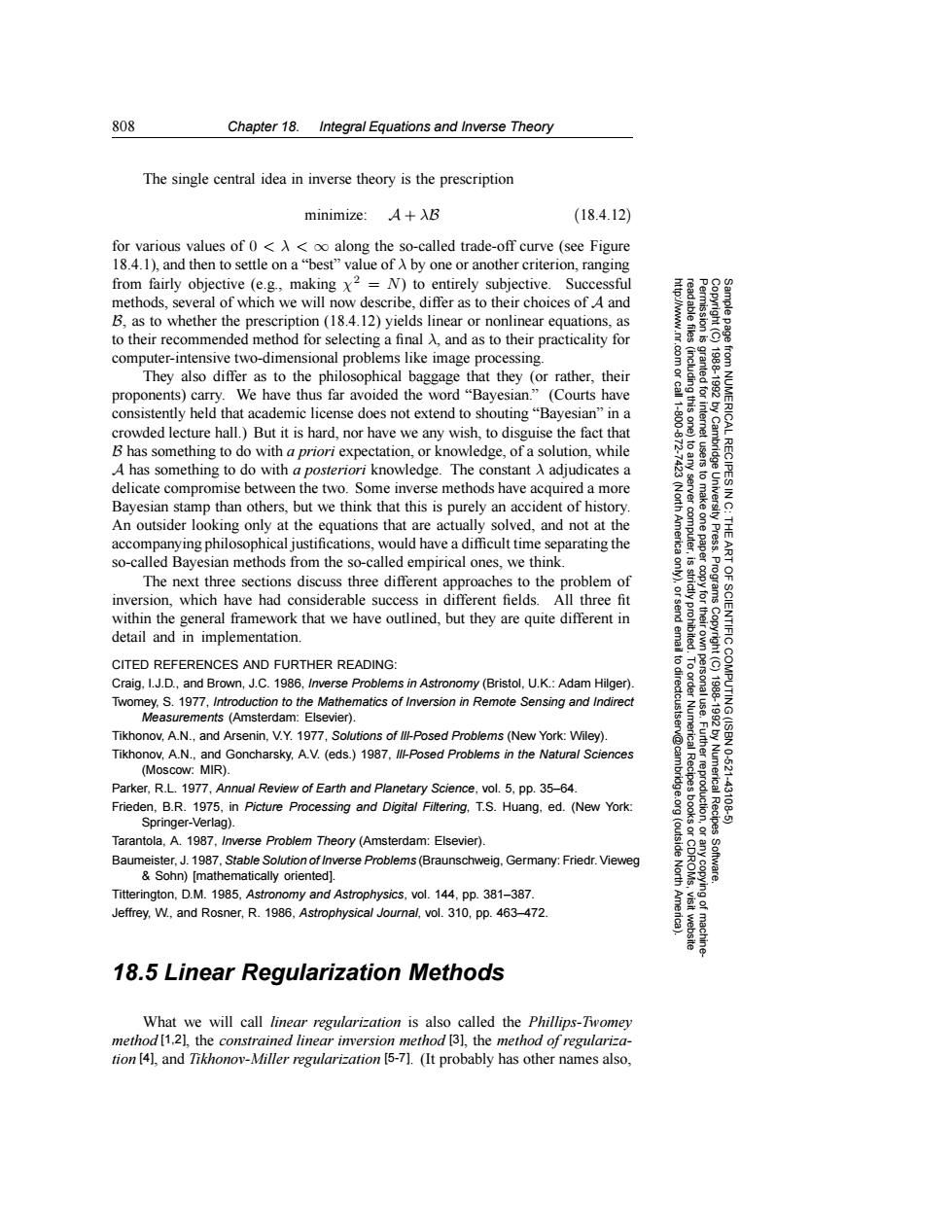正在加载图片...

808 Chapter 18.Integral Equations and Inverse Theory The single central idea in inverse theory is the prescription minimize:A+入B (18.4.12) for various values of 0<A<oo along the so-called trade-off curve (see Figure 18.4.1),and then to settle on a"best"value of A by one or another criterion,ranging from fairly objective (e.g.,making x2=N)to entirely subjective.Successful methods.several of which we will now describe.differ as to their choices ofA and B,as to whether the prescription(18.4.12)yields linear or nonlinear equations,as to their recommended method for selecting a final A,and as to their practicality for 8 computer-intensive two-dimensional problems like image processing. They also differ as to the philosophical baggage that they (or rather,their proponents)carry.We have thus far avoided the word "Bayesian."(Courts have consistently held that academic license does not extend to shouting"Bayesian"in a crowded lecture hall.)But it is hard,nor have we any wish,to disguise the fact that B has something to do with a priori expectation,or knowledge,of a solution,while A has something to do with a posteriori knowledge.The constant A adjudicates a delicate compromise between the two.Some inverse methods have acquired a more Bayesian stamp than others,but we think that this is purely an accident of history. An outsider looking only at the equations that are actually solved,and not at the 需 accompanying philosophical justifications,would have a difficult time separating the so-called Bayesian methods from the so-called empirical ones,we think. The next three sections discuss three different approaches to the problem of inversion,which have had considerable success in different fields.All three fit within the general framework that we have outlined,but they are quite different in OF SCIENTIFIC detail and in implementation. CITED REFERENCES AND FURTHER READING: 6 Craig,I.J.D.,and Brown,J.C.1986,Inverse Problems in Astronomy(Bristol,U.K.:Adam Hilger). Twomey,S.1977,Introduction to the Mathematics of Inversion in Remote Sensing and Indirect Measurements (Amsterdam:Elsevier). Tikhonov.A.N..and Arsenin,V.Y.1977,Solutions of Il/-Posed Problems(New York:Wiley). Tikhonov,A.N.,and Goncharsky,A.V.(eds.)1987,Il/-Posed Problems in the Natural Sciences (Moscow:MIR). Parker,R.L.1977,Annual Review of Earth and Planetary Science,vol.5,pp.35-64 Frieden,B.R.1975,in Picture Processing and Digital Filtering,T.S.Huang,ed.(New York: Numerical Recipes 10621 43106 Springer-Verlag). Tarantola,A.1987,Inverse Problem Theory (Amsterdam:Elsevier). (outside Baumeister,J.1987,Stable Solution of Inverse Problems(Braunschweig.Germany:Friedr.Vieweg Sohn)[mathematically oriented]. North Software. Titterington,D.M.1985.Astronomy and Astrophysics,vol.144,pp.381-387. Jeffrey,W.,and Rosner,R.1986,Astrophysical Journal,vol.310,pp.463-472. 18.5 Linear Regularization Methods What we will call linear regularization is also called the Phillips-Twomey method (1.21,the constrained linear inversion method 31,the method of regulariza- tion [41,and Tikhonov-Miller regularization [5-71.(It probably has other names also.808 Chapter 18. Integral Equations and Inverse Theory Permission is granted for internet users to make one paper copy for their own personal use. Further reproduction, or any copyin Copyright (C) 1988-1992 by Cambridge University Press. Programs Copyright (C) 1988-1992 by Numerical Recipes Software. Sample page from NUMERICAL RECIPES IN C: THE ART OF SCIENTIFIC COMPUTING (ISBN 0-521-43108-5) g of machinereadable files (including this one) to any server computer, is strictly prohibited. To order Numerical Recipes books or CDROMs, visit website http://www.nr.com or call 1-800-872-7423 (North America only), or send email to directcustserv@cambridge.org (outside North America). The single central idea in inverse theory is the prescription minimize: A + λB (18.4.12) for various values of 0 <λ< ∞ along the so-called trade-off curve (see Figure 18.4.1), and then to settle on a “best” value of λ by one or another criterion, ranging from fairly objective (e.g., making χ2 = N) to entirely subjective. Successful methods, several of which we will now describe, differ as to their choices of A and B, as to whether the prescription (18.4.12) yields linear or nonlinear equations, as to their recommended method for selecting a final λ, and as to their practicality for computer-intensive two-dimensional problems like image processing. They also differ as to the philosophical baggage that they (or rather, their proponents) carry. We have thus far avoided the word “Bayesian.” (Courts have consistently held that academic license does not extend to shouting “Bayesian” in a crowded lecture hall.) But it is hard, nor have we any wish, to disguise the fact that B has something to do with a priori expectation, or knowledge, of a solution, while A has something to do with a posteriori knowledge. The constant λ adjudicates a delicate compromise between the two. Some inverse methods have acquired a more Bayesian stamp than others, but we think that this is purely an accident of history. An outsider looking only at the equations that are actually solved, and not at the accompanying philosophical justifications, would have a difficult time separating the so-called Bayesian methods from the so-called empirical ones, we think. The next three sections discuss three different approaches to the problem of inversion, which have had considerable success in different fields. All three fit within the general framework that we have outlined, but they are quite different in detail and in implementation. CITED REFERENCES AND FURTHER READING: Craig, I.J.D., and Brown, J.C. 1986, Inverse Problems in Astronomy (Bristol, U.K.: Adam Hilger). Twomey, S. 1977, Introduction to the Mathematics of Inversion in Remote Sensing and Indirect Measurements (Amsterdam: Elsevier). Tikhonov, A.N., and Arsenin, V.Y. 1977, Solutions of Ill-Posed Problems (New York: Wiley). Tikhonov, A.N., and Goncharsky, A.V. (eds.) 1987, Ill-Posed Problems in the Natural Sciences (Moscow: MIR). Parker, R.L. 1977, Annual Review of Earth and Planetary Science, vol. 5, pp. 35–64. Frieden, B.R. 1975, in Picture Processing and Digital Filtering, T.S. Huang, ed. (New York: Springer-Verlag). Tarantola, A. 1987, Inverse Problem Theory (Amsterdam: Elsevier). Baumeister, J. 1987, Stable Solution of Inverse Problems (Braunschweig, Germany: Friedr. Vieweg & Sohn) [mathematically oriented]. Titterington, D.M. 1985, Astronomy and Astrophysics, vol. 144, pp. 381–387. Jeffrey, W., and Rosner, R. 1986, Astrophysical Journal, vol. 310, pp. 463–472. 18.5 Linear Regularization Methods What we will call linear regularization is also called the Phillips-Twomey method [1,2], the constrained linear inversion method [3], the method of regularization [4], and Tikhonov-Miller regularization [5-7]. (It probably has other names also